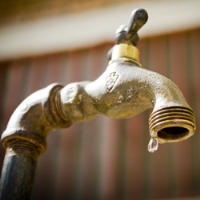Drought Is More than Looming Threat to 1,000 without Water in East Porterville

Governor Jerry Brown did not mention the dusty Central Valley community of East Porterville on Friday when he announced an executive order to streamline drought relief for households left without running water after their wells went dry.
But to the nearly 1,000 folks who have been dry for weeks, if not months, it may have sounded like he was whispering in their ear. Funding from the California Disaster Assistance Act will provide water for sanitation and drinking to those who have run dry.
The state will assist local agencies in purchasing and distributing the water. The State Water Resources Control Board, the Department of Water Resources and the Governor’s Offices of Emergency Services and Planning and Research are all affected by the order.
East Porterville is an unincorporated rural area in Tulare County with around 7,300 residents. They have had wells go dry before in bad times, but no one remembers it being this dire. California is in the third year of drought and is experiencing its warmest year on record. The governor declared a drought emergency at the beginning of 2014.
Last month, county employees and volunteers went door-to-door dropping off 12 gallons of bottled water per person at 185 homes in East Porterville occupied by 960 people. The water was expected to last about three weeks. Another 4,000 bottles were stashed at the local fire station for people to pick up as needed. The total cost of the giveaway was put at $30,000.
Angelica Gallegos told the Fresno Bee her household, which included her husband, three kids and two other adults, has been dry for four months. Tulare County Office of Emergency Services Manager Andrew Lockman said he began getting a trickle of calls about dry wells in February and by June it was gushing.
Groundwater accounts for 30-40% of the state’s total water supply, but up until now California was the only Western state that didn’t manage the resource. The state had already been pumping more water from underground basins than was being replaced for years before the drought. The U.S. Geological Survey (USGS) remarked in its 2009 report (pdf) on the six-fold increase in pumping of the giant Central Valley aquifer between 1962 and 2003 that, “Pumpage is physically possible to measure; yet in the Central Valley it is one of the least certain components of the entire water budget.”
Because California property owners essentially have had the right to all the water beneath them, the state hasn’t bothered setting up a system to monitor where, and how many, wells are drilled and how much water is pumped out.
That changed somewhat last week when the governor signed three bills to monitor and manage groundwater resources. Local groundwater management agencies must be identified by 2017; groundwater basins being sucked dry must have sustainability plans by 2020; other less-stressed basins must have plans by 2022; and all the other basins must have plans by 2040.
Hopefully by then, East Porterville residents won’t still be living on bottled water.
–Ken Broder
To Learn More:
Volunteers Deliver Bottled Water to Drought-Stricken Community (by Lewis Griswold, Fresno Bee)
Many Rural Californians Are Already Out of Water (by Sara Jerome, Water Online)
Jerry Brown Signs Groundwater Legislation (by David Siders, Sacramento Bee)
Governor Brown Streamlines Relief Efforts for Families with Drinking Water Shortages Due to Drought (Office of the Governor)
Central Valley Farmers Keep Drought Losses at $1.7 Billion by Overtaxing Groundwater (by Ken Broder, AllGov California)
- Top Stories
- Controversies
- Where is the Money Going?
- California and the Nation
- Appointments and Resignations
- Unusual News
- Latest News
- California Forbids U.S. Immigration Agents from Pretending to be Police
- California Lawmakers Urged to Strip “Self-Dealing” Tax Board of Its Duties
- Big Oil’s Grip on California
- Santa Cruz Police See Homeland Security Betrayal in Use of Gang Roundup as Cover for Immigration Raid
- Oil Companies Face Deadline to Stop Polluting California Groundwater





